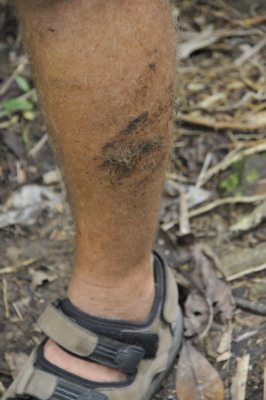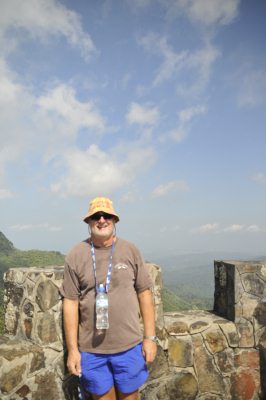El Yunque

|
El Yunque National Forest
 The West Peak of El
Toro, taken from the Yokahu Tower
After a few false starts and U turns we found El Yunque, formerly
known as Luquillo National Forest which is about forty five minutes from our
marina. It is the only rain forest in the US National Forest System and the home
of the Coqui - Eleutherodactylus Portorisencis. The Coqui is the common name for
an endemic group of tiny frogs - no bigger than an inch - his name comes
from the sound he makes from early afternoon and all night. The noise Co-quee
can be up to one hundred decibels. The story from Taino myth goes: An old Taino
chief called Guajaona wanted all the women in the tribe for himself. He waited
until all the men had gone fishing and attacked the sentries, abducting all the
women. That night all the children cried for their mothers. Legend says
Yocahu (a Taino God) was so moved by the plaintive cries of the children
wanting to be nursed that he turned them into Coqui so they could survive. It is
a fifty fifty call as to whether they keep you awake or puts you to sleep. Guess
how it affects Bear and his snoring ability.
Braced with the success of finding West Marine yesterday we felt
suitably confident we could find the place. The forest is on the slopes of the
Sierra de Luqillo Mountains and covers some twenty eight thousand acres, making
it the largest block of land on Puerto Rico. El Toro is the highest peak rising
to three thousand, five hundred and thirty seven feet. El Yunque is the second
highest. Typical yearly rainfall can be up to 6 m (240 inches)
per year, which constitutes more than 380,000,000 m³ (100 billion US gallons)
spread over the forest. El Yunque is composed of four different forest
vegetation areas: Tabonuco Forest, Palo Colorado Forest, Sierra Palm Forest and
Dwarf Forest.
 El Portal Rain Forest Centre:
Opened in 1996, the El Portal Rain Forest Center is designed
to give visitors an introduction to the rain forest. A walkway set at sixty
feet above the ground allows for a view of the tops of trees, and another
walkway winds along tree bases. Exhibits at the center focus on the plants and
animals of the rain forest, the importance of rain forests around the world, and
threats to rain forests and efforts to conserve them.
  We arrived at the
beautiful Visitors Centre, paid our $3 entrance fee and soon settled in the
air-conditioned theatre to watch an interesting film
about El Yunque. Then to the tea room for a slab of
delicious cake and a real fruit smoothie which set us up to go and
explore.
  On all the supports
on the upper level were stunning orchids. The second chap has trailed over the
ceiling with his roots
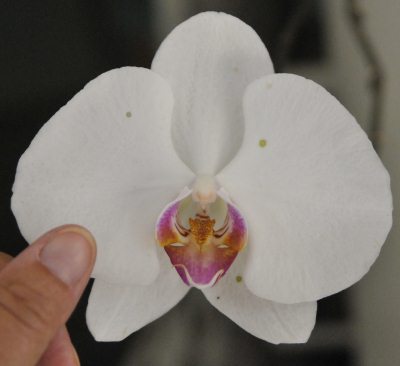  This one was enormous against my thumb. A lovely pink with a
face.
  The local parrot
evokes great love in Puerto Rico. This is a picture I took
from an information film. A portrait of a much loved bird called
Madre
We then left the
Visitors Centre, got back in the car to head up to the next stop. You are given
a map in both Spanish and English on the reverse. It tells you distances and
approximate walking times and distances for the trails. You can see plenty just
by following the winding road for thirteen kilometers. There are five stops with
car parks, refreshments and a stop for food.
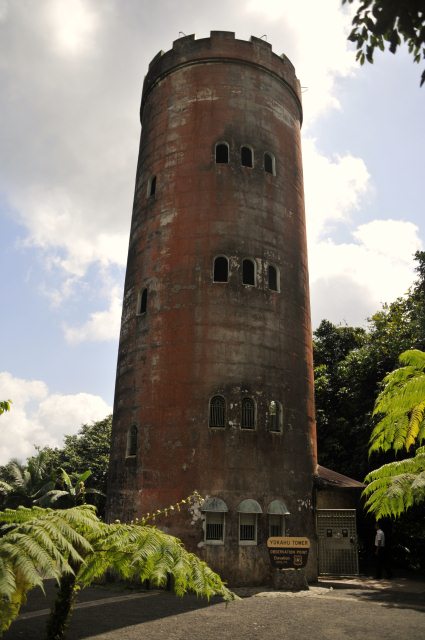 The Yokahu Tower
The Forest Service built the seventy five
foot high Yokahu structure in 1962 as an observation tower. There are
ninety eight steps to get to the top, but well worth it as the panoramic views
are spectacular. It was constructed in the style of the much older Mount
Britton Tower.
 The view from the top of the Yokahu Tower, Bear looking North
East. Over his left shoulder is The Sandy Hills
Condominiums. Over his right the beach of San
Miguel - turtle nesting area
  Bear pointed
out this tiny observation tower in the centre of the
picture. A closer look, how stunning History
The forest region was initially set aside in
1876 by the King Alfonso XII of Spain, and represents one of the oldest reserves in the Western
Hemisphere. It was established as the Luquillo Forest Reserve on the
17th of January 1903 by the General Land Office with 65,950 acres, and became a National Forest in
1906. It was renamed Caribbean National Forest on the 4th
of June 1935. It is home to over two hundred species of trees and plants,
twenty three of which are found nowhere else. The critically endangered Puerto
Rican Amazon (Amazona vittata), with an estimated wild population of
thirty individuals, occurred exclusively in this forest until the 19th
of November 2006, when another wild population was released by the
Department of Natural Resources in the municipality of
Utuado's Rio Abajo State Forest. There is a great deal of love
and dedicated workers doing their best to keep this little parrot
safe. An Executive Order signed by President George W. Bush on the 2nd of April 2007 changed the name of the Caribbean National Forest to El Yunque National Forest, better reflecting the cultural and historical feelings of the Puerto Rican people.
Back in the car to the next stop to walk to Mount Britton Tower. En route, we both stopped dead when we heard a parrots squawk. Bear maintains he was stepping off the path to allow me room to swing the camera, as next thing he was doing a perfect summersault down the muddy bank, his camera held aloft and somehow saving the water bottles. I wouldn't mind but he had a new t-shirt on and he would be muddy for the rest of the day. I was in hysterics when an American said "Don't feel guilty, it's perfectly normal to laugh when an adverse happening has occurred to a loved one", with that I couldn't see for the tears of laughter. When do Americans show a sense of humour, do they have one ???

His SAF (Slapped Arse Face) says it all as we continued up the trail, with him muttering something like Soddin' birds
El Yunque from the top. Bears spirits perked up at the top of Britton Tower
The walk back to the
car was uneventful (Thanks)
Big Bear Attenborough actually tried to take
some shots of butterflies. Bloody things wouldn't
sit still - Oh not quite there yet
then.
 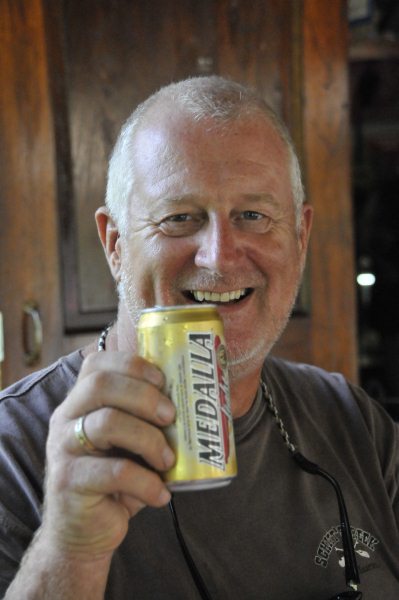 Next stop on the
road down the hill was at Sierra Palm to see the plaque.
Bear smiling with a beer. We met Mario an Italian-New Yorker, been here
four months and cooks the best chicken kebabs in the world
 Our last stop was
actually the first on the way up, but we saved it till last - The Coca Falls, OK so they are only small, but I wanted to
take pictures of inside out flowers and heliconia
ALL IN ALL
AN EVENTFUL AND INTERESTING DAY
A SPECTACULAR FOREST HIKE
- TIME FOR BED SAID
ZEBEDEE
NOT UNTIL AFTER A VERY LONG SHOWER MUDDY BOY
|

